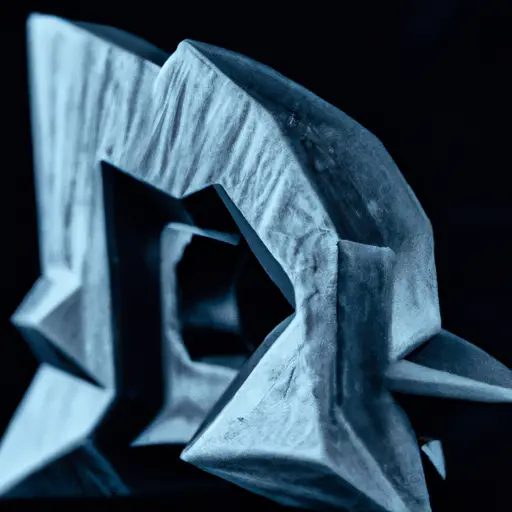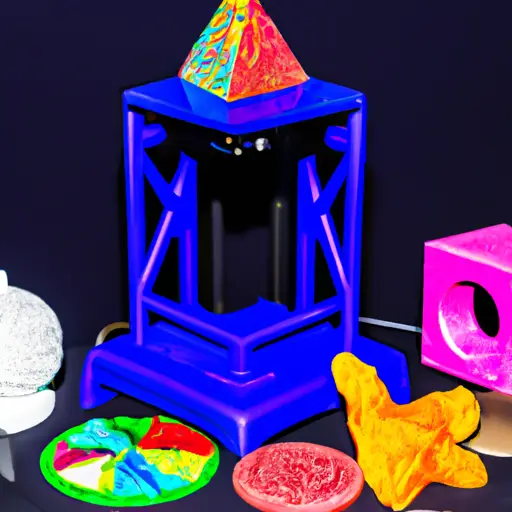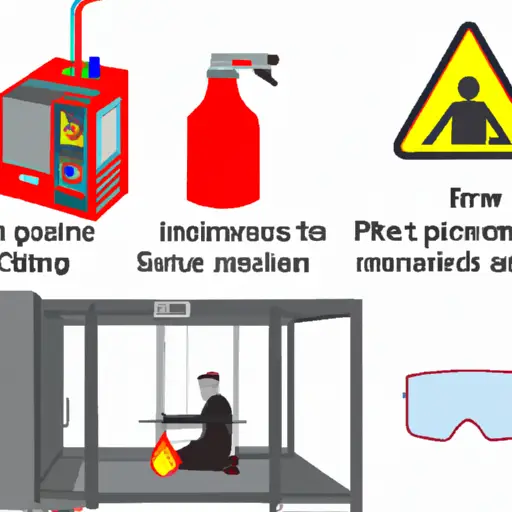Delve into the dynamic realm of 3D printing with our comprehensive glossary of essential terms.
Unlock the intricacies of this cutting-edge technology as we explore a myriad of printing techniques, materials, software, and post-processing methods.
From additive manufacturing to z-axis, our objective and informative guide aims to demystify the jargon and equip you with the knowledge necessary to navigate the world of 3D printing with confidence.
Prepare to embark on an enlightening journey through the realms of this revolutionary industry.
Types of 3D Printers
When it comes to the world of 3D printing, there are various types of 3D printers that utilize different technologies and materials for the manufacturing process. Each type of 3D printer has its own pros and cons, making them suitable for different applications and industries.
One type of 3D printer is the Fused Deposition Modeling (FDM) printer, which is popular due to its low cost and ease of use. FDM printers work by melting and extruding thermoplastic filament to build the object layer by layer. They are commonly used in industries such as prototyping, education, and hobbyist projects.
Another type is the Stereolithography (SLA) printer, which uses a liquid resin that is cured by a laser or UV light. SLA printers are known for their high precision and smooth surface finish, making them suitable for applications like jewelry, dental models, and architectural prototypes.
Selective Laser Sintering (SLS) printers, on the other hand, use a laser to fuse powdered materials together, creating durable and functional parts. SLS printers are commonly used in industries like aerospace, automotive, and medical, due to their ability to produce complex geometries and strong parts.
Printing Technologies
Among the various types of 3D printers, understanding the different printing technologies is crucial for selecting the most suitable one for a specific project or application. Advancements in printing technology have led to the development of several printing techniques, each with its own advantages and limitations.
Here are two sub-lists that summarize the different printing technologies and their impact on various industries:
1. Extrusion-based technologies:
- Fused Deposition Modeling (FDM): It is one of the most common and affordable 3D printing technologies. FDM works by melting and extruding plastic filament layer by layer to create the object. This technology has been widely adopted by industries such as automotive, aerospace, and consumer goods.
- Selective Laser Sintering (SLS): SLS uses a high-powered laser to selectively fuse powdered material, such as plastic or metal, to create the object. This technology is particularly useful for complex geometries and has found applications in industries like healthcare, defense, and architecture.
2. Photopolymerization-based technologies:
- Stereolithography (SLA): SLA uses a UV laser to selectively cure liquid resin layer by layer, creating the object. This technology provides high resolution and smooth surface finish, making it suitable for industries like jewelry, dental, and prototyping.
- Digital Light Processing (DLP): DLP is similar to SLA but uses a digital light projector to cure the resin. This technology offers faster printing speeds and is used in industries such as entertainment, education, and manufacturing.
These advancements in printing technology have revolutionized various industries by enabling rapid prototyping, customization, and cost-effective production. From healthcare to automotive, aerospace to fashion, 3D printing has made significant contributions, transforming traditional manufacturing processes and unlocking new possibilities for innovation.
Materials and Filaments
One of the key factors in 3D printing success is the proper selection and utilization of suitable materials and filaments. Filament compatibility and considerations play a crucial role in achieving the desired print quality and functionality. Advances in 3D printing materials have expanded the possibilities for creating objects with enhanced properties, such as strength, flexibility, and heat resistance.
To help you understand the different materials and filaments used in 3D printing, here is a table outlining some common options:
| Material | Properties | Applications |
|---|---|---|
| PLA | Biodegradable, easy to print, low cost | Prototyping, models, decorative items |
| ABS | Durable, impact-resistant, heat-resistant | Functional prototypes, mechanical parts |
| PETG | Strong, flexible, chemical-resistant | Functional parts, food-safe containers |
| Nylon | High strength, flexibility, low friction | Functional parts, gears, bearings |
| TPU | Flexible, elastic, soft touch | Wearable devices, shoe soles, phone cases |
| Carbon Fiber | High strength, lightweight | Aerospace components, automotive parts |
These are just a few examples of the materials and filaments available for 3D printing. With ongoing advancements in materials science, the range of options continues to expand, offering new possibilities for various industries and applications. It is important to consider the specific requirements of your project when selecting the appropriate material to ensure optimal results.
CAD Software and Design Tools
As technology continues to evolve, the field of 3D printing has greatly benefited from the development of CAD software and design tools, which have revolutionized the way objects are created and brought to life. These tools have made it possible for individuals and businesses to design and customize objects with precision and efficiency. Some of the key CAD software and design tools used in the 3D printing industry include:
-
Customizable CAD software for 3D printing:
-
CAD software, such as Autodesk Fusion 360 and SolidWorks, allows users to create intricate and complex 3D models that can be printed using various materials and filaments.
-
These software programs offer a wide range of features and tools that enable users to design, modify, and visualize their creations before they are brought to life through 3D printing.
-
Cutting edge design tools for advanced 3D printing projects:
-
Design tools like Rhino and Blender provide advanced capabilities for creating complex shapes and structures.
-
These tools often include features such as parametric modeling, mesh editing, and sculpting, which allow designers to push the boundaries of what can be achieved with 3D printing.
Post-Processing Techniques
Several post-processing techniques can be used to enhance the appearance and functionality of 3D printed objects. These techniques include surface finishing methods and quality control measures. Surface finishing methods are used to improve the surface texture and overall aesthetics of the printed object. Some common surface finishing methods include sanding, polishing, and painting. Sanding can be used to remove any rough areas or visible layer lines, while polishing can give the object a smooth and shiny finish. Painting, on the other hand, allows for customization and the addition of colors to the object.
In addition to surface finishing methods, quality control measures are also important in post-processing 3D printed objects. These measures ensure that the printed object meets the required specifications and standards. Quality control techniques can include dimensional accuracy checks, strength and durability tests, and visual inspections. Dimensional accuracy checks involve measuring the printed object to ensure that it matches the intended dimensions. Strength and durability tests assess the structural integrity of the object, while visual inspections look for any defects or imperfections. By implementing these quality control measures, the overall quality and functionality of the 3D printed object can be improved.
The following table provides a visual representation of the surface finishing methods and quality control measures used in post-processing 3D printed objects:
| Surface Finishing Methods | Quality Control Measures |
|---|---|
| Sanding | Dimensional Accuracy |
| Polishing | Strength and Durability |
| Painting | Visual Inspections |
Common 3D Printing Terminology
Common 3D printing terminology includes various technical terms and concepts that are essential to understand in order to navigate the world of additive manufacturing. Here are some key terms to familiarize yourself with:
-
3D Printing Troubleshooting:
-
Layer Separation: This occurs when the layers of a print do not adhere properly, resulting in a weak structure. It can be caused by incorrect temperature settings or an issue with the print bed.
-
Warping: Warping happens when the corners of a print lift or curl upwards. It is often caused by uneven cooling or insufficient adhesion to the print bed.
-
3D Printing Applications:
-
Rapid Prototyping: 3D printing enables quick and cost-effective production of prototypes, allowing designers to test and refine their ideas before manufacturing.
-
Customization: Additive manufacturing allows for the creation of highly customized products, tailored to individual needs and preferences. This is particularly useful in industries such as healthcare and aerospace.
Understanding these terms will help you troubleshoot common issues that may arise during the 3D printing process and also appreciate the wide range of applications this technology offers. By familiarizing yourself with these concepts, you can make the most of additive manufacturing and explore its potential in various industries.
Frequently Asked Questions
What Are Some Common Challenges or Difficulties That Beginners Face When Using 3D Printers?
When beginners start using 3D printers, they often encounter common challenges such as understanding the safety precautions and guidelines, learning how to operate the printer efficiently, and troubleshooting technical issues that may arise during the printing process.
Are There Any Safety Precautions or Guidelines That Should Be Followed When Operating a 3D Printer?
When operating a 3D printer, it is crucial to follow safety precautions and guidelines. Beginners often face challenges, such as understanding the printing duration. Ensuring proper ventilation, using protective gear, and monitoring the printing process are essential for a safe and efficient operation.
How Long Does It Typically Take to Print an Object Using a 3D Printer?
The time it takes to print an object using a 3D printer can vary depending on several factors. Optimizing printing speed on a 3D printer involves considering factors such as the complexity of the object, layer height, infill density, and printer settings.
Can 3D Printers Be Used to Print Objects With Moving Parts or Complex Geometries?
Yes, 3D printers can be used to print objects with moving parts and complex geometries. This capability allows for the creation of intricate designs and functional prototypes, revolutionizing various industries such as aerospace, automotive, and healthcare.
Are There Any Limitations or Restrictions on the Size of Objects That Can Be Printed Using a 3D Printer?
There are limitations and restrictions on the size of objects that can be printed using a 3D printer. Factors such as the printer’s build volume, material availability, and structural integrity must be considered when determining the size of the object to be printed.
Conclusion
In conclusion, familiarizing oneself with the essential terms and concepts in the world of 3D printing is crucial for anyone interested in this technology.
From understanding the different types of printers and printing technologies to knowing the various materials and design tools involved, this glossary provides a comprehensive overview.
By staying updated on the terminology and advancements in 3D printing, individuals can better navigate this rapidly evolving field and harness its potential for innovation and creativity.
How can we afford to overlook the possibilities that 3D printing offers?



